
There are piles and piles of lobbying money wanting access to the same people we will want to see on May 12, ALS Advocacy Day.
The words "piles and piles" really don't give the enormity justice.
See the image at the left from opensecrets.org with the 2008 lobbying expenses by industry groups. Those are not campaign contributions (those are whole different piles of money). Those are lobbying investments. Look at those numbers!
In one year America has spent these piles of money on gaining access to our legislators. Those piles of money overshadow America's anthill investment in ALS research. What is wrong with this picture?
In one year America has spent these piles of money on gaining access to our legislators. Those piles of money overshadow America's anthill investment in ALS research. What is wrong with this picture?
Bring your "A" game to Washington for sure. The ALS message needs to be heard.
p.s. Someday I would love to see an ALS Advocacy Day prix fixe menu at some of the nice restaurants where the decision-makers lunch with the lobbyists. Chilled Ensure, Jevity with a Liquid Centrum Garnish, Puree Surprise, Filtered Mashed Potatoes, Gravity-Fed Cabernet Sauvignon...
















